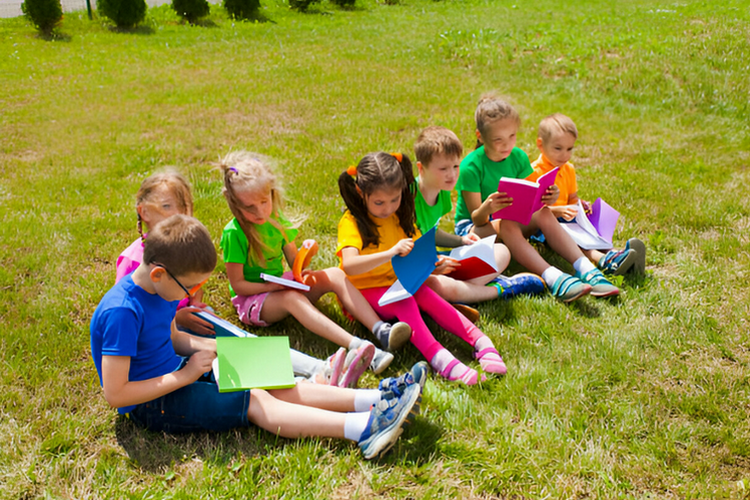


Fun activities for afterschool programs are more than just time-fillers; they are investments in kids’ social, educational, and physical progress. By participating in a variety of physical, artistic, and educational activities, children can enjoy a wide range of benefits:
In this article, we will explore 12 exciting afterschool programs and fun educational activities designed to keep kids interested and involved. From energetic games like the Active Game Olympics to collaborative art projects such as Collaborative Mural Projects, these activities ensure that every child discovers something that sparks their interest.
We will also discuss sensory bins that provide tactile stimulation, kitchen chemistry experiments for young scientists, and the power of storytelling in developing language skills. Additionally, we’ll share some culinary adventures for those aspiring young chefs! Whether you’re looking for new ideas for fun activities or want to enhance your current afterschool programs for kids, this article has got you covered.
Physical activities are crucial to any lively and fun afterschool programs for kids. They give children a way to release their endless energy and teach them about the importance of health and fitness. It’s not just about keeping kids busy; it’s about showing them how enjoyable it can be to move their bodies and stay active.
The Active Game Olympics is an exciting event where children can take part in various high-energy activities that promote teamwork, coordination, and friendly competition:
This mini-Olympic event keeps children engaged and teaches them important lessons in perseverance and sportsmanship.
The Outdoor Adventure Scavenger Hunt combines the excitement of exploration with a love for nature:
Children come back from scavenger hunts with more than just treasures; they develop a deeper understanding of the environment and the significance of physical activity.
Each activity provides an enjoyable way for children to discover their physical abilities while understanding the importance of working together and achieving personal goals. Educators and parents can ensure that kids continue to lead active lifestyles even after school by including these dynamic physical afterschool activities in their programs.
Artistic activities allow kids to express creativity and develop fine motor skills. Engaging in art creation can act as a soothing and relaxing activity, helping children unwind after a long day at school. It is not just about the result—the process itself can be incredibly beneficial, helping to build self-esteem, improve decision-making skills, and boost concentration.
Creating a large-scale mural together with other students to decorate the school or community
A collaborative mural project can be an excellent artistic activity for after-school programs. This can involve all children coming together and contributing their unique ideas to create a beautiful piece of art that adds vibrancy to the school or community.
How it works:
These fun activities for afterschool programs not only help them learn about color mixing, brush techniques, and composition but also foster teamwork as they work together towards a shared goal.
A step-by-step craft workshop where kids can learn new techniques and make their own unique creations.
Another engaging artistic after-school activity is setting up a DIY craft workshop. This can range from creating personalized bookmarks, designing greeting cards, and making clay sculptures to building cardboard castles.
How it works:
Crafting not only helps kids explore different materials and techniques but also allows them to express their creativity in tangible forms. The joy of making something with their own hands can give children a great sense of accomplishment.
Artistic and educational afterschool activities like these empower kids to tap into their creative abilities while having fun. It’s all about giving children the freedom to explore and create.
Sensory afterschool activities offer kids unique ways to engage with the world around them and participate in any educational programs. Children enhance their cognitive development by stimulating their senses and gaining a deeper understanding of their environment. Sensory play is not just fun; it’s a crucial aspect of learning that encourages exploration and discovery through touch, smell, sight, sound, and taste.
A classic favorite in sensory after-school activities is the creation of messy play sensory bins. These bins can be filled with an array of materials to captivate children’s tactile senses:
When setting up these bins:
Engage children’s olfactory senses with a scent guessing game that challenges them to identify different aromas while blindfolded. This activity not only sharpens their sense of smell but also builds vocabulary as they learn new words to describe scents. To set up this game:
This can be turned into an opportunity for kids to engage in educational activities by discussing where each scent comes from or what it is typically used for in everyday life.
Sensory containers can further expand this activity:
Sensory activities like these are essential in afterschool programs as they provide educational opportunities for kids to learn through direct experience. They stimulate curiosity, foster cognitive growth, and support emotional regulation by offering calming or invigorating sensory input based on individual needs.
By incorporating these sensory experiences into an afterschool curriculum, educators create an inclusive learning environment that caters to diverse learning styles and preferences. Activities for afterschool programs are designed to be flexible, allowing for adaptation based on age levels or interests while ensuring that kids feel engaged and excited about exploring their senses.
Educational afterschool activities are a great way to combine fun and learning for kids. They go beyond just keeping kids occupied after school and create an environment that sparks their curiosity, keeps them engaged, and nurtures a love for learning.
The kitchen is full of amazing scientific discoveries waiting to be explored. With adult supervision, kids can embark on Kitchen Chemistry Adventures. In this exciting journey, they can learn about scientific concepts through hands-on experiments using everyday ingredients found in their kitchen.
Baking Soda and Vinegar Volcano
One example of a fun experiment is the Baking Soda and Vinegar Volcano. By mixing baking soda (a base) with vinegar (an acid), kids can witness a chemical reaction that results in an effervescent eruption – just like a volcano!
Making Homemade Rock Candy
Another interesting activity is making homemade rock candy to learn about the process of crystallization. Using only sugar, water, and a string, children can observe how sugar crystals gradually form over time to create delicious candy treats.
These educational activities not only make science more tangible and relatable but also give kids a sense of accomplishment when they see the results of their culinary creations.
Math doesn’t have to be boring or intimidating. It can be turned into an exciting adventure with the Math Maze Challenge. This activity involves designing a maze that incorporates math problems that must be solved to navigate through it.
Here’s how you can set up your own Math Maze Challenge:
For younger children, you can include simple addition or subtraction problems. Older kids can tackle more complex challenges involving multiplication, division, fractions, or even algebra.
These fun activities for afterschool programs not only help improve math skills but also encourage critical thinking and problem-solving abilities. It’s not just about finding the right answer but also using that knowledge to make decisions and choose the correct path in the maze.
These types of educational activities offer numerous benefits for afterschool programs for kids:
By incorporating these activities into after-school programs, we can create a holistic learning experience that combines academic growth with personal development – all while having fun!
Storytelling activity and language development are closely connected when it comes to children’s intellectual growth. Engaging afterschool programs with a focus on storytelling can:
Creating their puppet show can be an exciting storytelling activity for children. This experience allows them to use their imagination and bring characters to life through colorful stories.
Here’s how you can organize a puppet show activity:
Children can work in groups, assigning roles for:
This not only promotes teamwork but also allows them to explore various aspects of storytelling and drama.
Example: A group of children might decide to write a story about ‘A Day in the Jungle’. They could create animal puppets and bring alive characters like ‘Larry the Lion’, ‘Ellie the Elephant’ or ‘Zara the Zebra’. Through their puppet show, they could narrate exciting adventures from the jungle.
Forming a book club is another excellent way of promoting language skills and nurturing a love for reading among children.
Here’s how you can set up a book club:
During these book club sessions, each child can:
This not only boosts their confidence but also improves their public speaking and comprehension skills.
Example: For children who are fans of adventure stories, a book like ‘Treasure Island’ by Robert Louis Stevenson could be an exciting choice for the club. As they dive into the thrilling adventures of young Jim Hawkins, they get to:
Incorporating storytelling and language activities in after-school programs can provide a fun and enriching learning experience for children. It’s a journey that takes them to magical places, introduces them to fascinating characters, and empowers them to create their own captivating stories.
Culinary afterschool activities are a delightful way to introduce kids to the world of cooking, helping them appreciate the diversity of flavors and textures that food offers. These activities not only cater to the taste buds but also serve as a hands-on educational experience, teaching kids about nutrition, food safety, and the chemistry behind cooking. Plus, they get to take pride in their creations. As they chop, mix, and season, children are also developing fine motor skills and learning to follow complex instructions—a tasty recipe for success.
Imagine an afterschool kitchen bustling with young chefs, each eager to whip up their signature dish—it’s the Junior Chef Cook-Off! This friendly competition is perfect for showcasing culinary skills and encouraging teamwork among budding gourmets.
There’s something magical about making ice cream from scratch. The transformation from simple ingredients to a creamy treat is almost like a culinary magic trick. Hosting a Homemade Ice Cream Party is not just fun; it’s also an edible science lesson.
Engaging in culinary after-school activities like these provides children with practical life skills while stirring their interest in new foods and cultures. They learn that cooking is more than just preparing food. It is an art form that involves all senses and can be incredibly satisfying.
Through baking projects for kids and ice cream-making sessions, children gain confidence in their abilities to create something from scratch. They’re also more likely to be open-minded about trying new foods when they’ve had a hand in making them.
As children progress through these culinary adventures, they carry forward not only fond memories but also valuable knowledge that will serve them well both inside and outside the kitchen.
A good mix of fun afterschool programs and activities for kids is essential for children’s overall development. It’s not just about keeping them busy; it’s about helping them develop social skills, emotional well-being, and a love for learning.
Parents, teachers, and program organizers can benefit greatly from implementing these fun after-school activities. Each activity has its own appeal and learning opportunities:
To make these activities even more engaging, you can create a schedule or have a weekly theme. This adds structure and makes children excited about their after-school time every day.
For families looking for resources and activities tailored to their children’s needs, 4Kids.com offers a comprehensive guide to events, deals, and fun things to do with kids near them.
Categories :
Tags :
We believe in building & supporting the community and that finding the resources and things to do for your kids should be easy. 4kids.com is a FREE online resource guide for families with kids in a city near you.
View All PostsNotifications